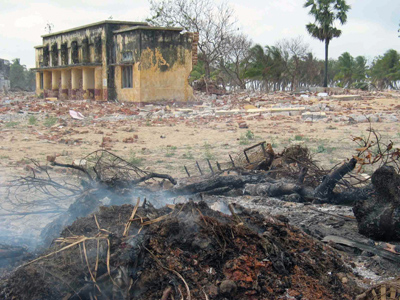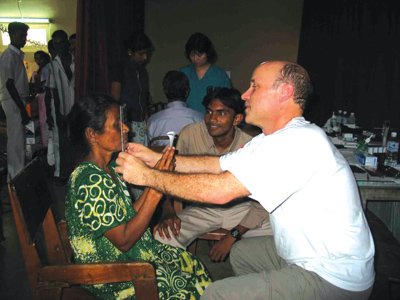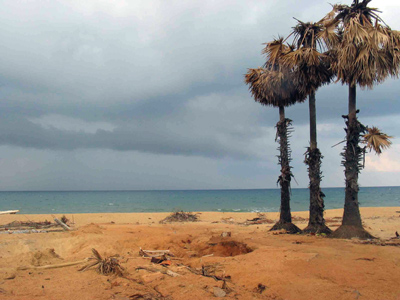The day after Christmas 2004 was a good morning to be a little early to church. While Mr. Rasanayagan puttered away in his home in Kalmunai, Sri Lanka, his wife had already left for the nearby Assembly of God church for 9 a.m. services.
The tsunami waves hit at 8:45 a.m.
 |
|
Bricks and smoldering garbage lie scattered in front of what is left of the post office in Kalmunai, Sri Lanka. |
A Call for Help
On December 26 in Portland, Ore., I watched the early news reports covering the earthquake and tsunami in southern Asia. Each hour, the death count soared. Like most of us, I was saddened and shocked by the enormous human suffering that resulted. I wished I could help.
 |
| Dr. McLain uses retinoscopic lens bars to demonstrate a patients reading prescription to her, as his interpretor looks on. |
So, in mid-January 2005, I joined a team that Lions International sent to Sri Lanka. I had been to Sri Lanka once before as a part of LIS, so I was excited about the chance to help those who had been affected and to renew my acquaintance with the Teardrop of India.
This time, our LIS team consisted of six optometrists and another six Lions club members who were experienced in optical dispensing. All 12 of us had served on many clinic trips in the past. We assembled at the airport in San Francisco late one evening in early February and boarded a Cathay Pacific flight for Hong Kong. From there, via Singapore, we reached Colombo, the capital of Sri Lanka, early the next evening after some 30 hours of travel.
The next morning, we met with local Lion members in Colombo and decided to split our team into two groups to respond to pleas for help from people on the eastern coast. One team headed as planned to the southwest coastline; this area had received the most international press. In fact, former Presidents Bush and Clinton were visiting at the same time as our clinic team.
The other groupmy groupwent to the central eastern coastline, an eight-hour drive from Colombo.
|
What is Lions In Sight? LIS clinic trips are very easy to participate in. Local foreign Lions Clubs do the groundwork; they procure patients and clinic space, smooth the way for participating optometrists to work within their countries, ease the import of clinical equipment and donated eyeglasses, and provide food and housing for the duration of the clinic. Participating optometrists usually pay only their airfare to and from the nearest airport, where they are met by local Lions members. All clinical equipment is provided by LIS. Being a clinic volunteer allows optometrists to help where there is extreme need and give a little hope where there is none. We get to learn in return, to serve and to enrich our own lives in ways we may not even perceive. For more information, go to www.lionsinsight.org. |
My team set up clinics in two east coast towns: Batticaloa and farther south in Kalmunai. We had only one day in each town. Still, we managed to see more than 400 patients at each clinic.
Early each morning, about 7:30 a.m., our team arrived at the clinic site, a church meeting hall in each case. We organized traffic flow and set up areas for the doctors and for optical dispensing. Local Lions members checked in patients and provided interpreters for each team member. The doctors then evaluated each patient for pathology and performed a vision exam (including examination with lens bars, retinoscope and some fine tuning with the lens bars in trial frame fashion). Then, we gave patients spherical equivalent lens prescriptions that they took to the dispensing area to look through the thousands of glasses that we brought along.
 |
|
On the east coast of Sri Lanka, village after village had populated the sandy beaches of the island. The sea provides sustenance to the local population. But on December 26, 2004, the waves brought only death and destruction. |
A second part of our clinic consisted of training local Lions members to read a spectacle prescription from an automated lensometer and to dispense glasses from both the stockpile we left behind and others that LIS was to send. (LIS has since sent more than 100,000 glasses.) Each town was to set up a permanent site where eyeglasses could be collected and where local people could receive examinations from local volunteer Sri Lankan eye care practitioners as follow-up to our service. In this way, our quick visit would hopefully have a lasting impact.
During the short time I had with each patient, my questions focused on their ocular needs. Most patients had suffered from the tsunami in ways more severe than simply losing a pair of glasses, but they had sublimated their grief so that they could continue to survive and move ahead. Only after the clinic, while talking with people in private, could I see that their grief was still presentlost lives remembered, houses and occupations gone.
Later, we toured areas in both towns where the waters had come ashore. We were told that 3,000 people died in Batticaloa, and another 5,000 were missing. In Kalmunai, 10,000 died, and more than 40% of the town had been inundated by the tsunamis waves, which destroyed almost 13,000 homes. The death tollmaybe a quarter of the populationwas only the tip of the iceberg. Many more had suffered injury and most of the survivors had lost their homes and belongings.
Get to the Church on Time
After our clinic day was over in Kalmunai, Mr. Rasanayagan, a local Lions member, told me his story as we sat on the porch of what was to be a new post office for Kalmunai. He was the general contractor for the building, which had mostly survived, though waves had topped it.
He told me of the crush and roar of the water, the screams and the crash of collapsing buildings. He told of soldiers stationed near the seas edge who managed to scamper up a large banyan tree. Eventually, there were 20 of them high up in the tree.
In the upstairs of the Assembly of God church, 300 people (including Mr. Rasanayagans wife) managed to save themselves. Another 100 were crammed in the second floor of Mr. Rasanayagans house, which was more than 200 yards from the sea. Water inundated the first floor, leaving behind a foot of sludge.
Mr. Rasanayagan and others watched the catastrophe from the upper floor of his home, paying close attention to the church. He was the contractor for both the church and his house. He knew if the church collapsed, his house would probably go too. Fortunately, both buildings remained standing.
Sadly, Mr. Rasanayagan later learned that his wifes mother and two sisters had died in the tsunami.
A year has gone by since our clinic in Sri Lanka. I know that many eyeglasses have been received by the Sri Lankan Lions Club through LIS. I have hope that these glasses have gone out from Colombo to those in need.
For the eastern coast of Sri Lanka, the tsunami was but another chapter of tragedy. The area has been severely affected by more than 20 years of ongoing civil war, consequences of which were obvious as we traveled the area. Those people I saw for a brief time made a warm impression on my heart, and I hope my fears for their future are unfounded.
Dr. McLain practices with Northwest Permanente in Portland, Ore. He has participated in 17 Lions In Sight trips in such locales as Bosnia, Palestine, Argentina, Nepal, Mexico and Panama.

